Today’s guest blogger, Anne Lower, is a true friend of STC! Anne was mentored by Blake, worked with us for a wonderfully collaborative period, and is a brilliant and articulate member of the writing community. Check out Anne’s blog, Princess Scribe. And a basketful of meows to her for this brilliant breakdown:
Year of Release: 2010
Written by: Scott Silver, Paul Tamasy and Eric Johnson; Story by Paul Tamasy, Eric Johnson and Keith Dorrington
Directed by: David O. Russell
Genre: Buddy Love (Family Love)
Subgenre: Institutionalized
Not your usual Buddy Love story, The Fighter weaves a complex tale of brotherly love — and war. Set in the gritty and violent world of competitive boxing, the script is laden with the tonal expressions of entrapment and imprisonment — of family, of addiction, of self-loathing and actual incarceration. Relentless in its examination of man’s (and woman’s) dual natures, The Fighter delivers a hard-packed one-two punch. It’s an emotional knockout.
Opening Image: Lowell Massachusetts, 1992. A tough, hard-edged blue-collar town.
A sequence alternating between old home videos and present day interviews reveals two brothers: older brother Dicky Eklund (Christian Bale) and younger half-brother Micky Ward (Mark Wahlberg). The videos show the brothers as children as they spar in the yard, under the constant supervision of the family matriarch, Alice (Melissa Leo).
Theme Stated: During the interview, Dicky points to his brother and says, “I taught him everything he knows.” Brother depends upon brother, our heroes are incomplete. The theme of The Fighter is that of family — how family is defined, the familial ties that bind, those that unravel, and the ties that are torn apart. Severed, possibly irrevocably.
Set-Up: Dicky Eklund is a man trapped in the past. He continuously relives his 1978 fight with Sugar Ray Leonard, which he lost in a decision but went the distance. Deemed “the pride of Lowell,” Dicky parades the streets of his home town, telling each and every person he encounters about his upcoming comeback, which is being filmed for HBO. Dicky believes this documentary to be the key to reinvigorating his career. The years have not been kind to him. He is gaunt; his behaviors excessive. He seems a shadow of his former self.
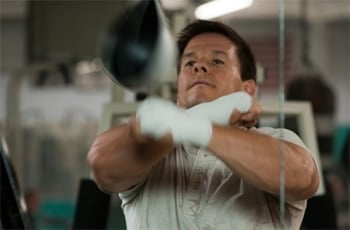
Micky Ward has his own troubles to face. At 30, his career as a welterweight boxer has not realized its full-blown promise. Managed by his mother, Alice, and trained by Dicky, Micky is at best a stepping-stone boxer — a fighter that others defeat on their way up.
At the gym, Micky waits on Dicky to help him train for an very important fight. Micky admits to the HBO crew that Dicky is often late, but that the wait is worth it. “Nobody pushes me harder,” Micky says. He suggests that the crew interview his sisters. Lined up against the wall, they are foul-mouthed, loud, and salty broads.
A cop and trainer, O’Keefe arrives. Micky tells him that Dicky is missing. “You know where he is,” says O’Keefe.
O’Keefe dons gloves and begins Micky’s workout — much to the dismay of Alice. She’s arrived, hair primped, makeup carefully applied, to show the film crew scrapbooks of Dicky’s short-lived career. It is obvious that Dicky is her favorite child. To her, he can do no wrong.
Across town, Dicky entertains his friends by re-enacting his infamous Leonard fight, where Sugar Ray hit the canvas. He pauses to smoke from a homemade bong. Now we know the reason for his emaciated appearance and odd behaviors. Dicky is addicted to crack.
Realizing that he is late to the training session, Dicky runs through the streets of Lowell and arrives at the gym. Now, Micky has two trainers — and they despise each other.
After a ruthless training session during which Micky has knocked his opponent down, the Ward family travels en masse to a local pub. Bartending is Charlene (Amy Adams), a former athlete working to pull herself out of the gutter of Lowell. Micky’s father, George, encourages Micky to talk to her. Micky is George’s favorite. Micky speaks to Charlene and discovers her to be, like his mother, a force to be reckoned with. Their attraction for one another is apparent; Micky asks for Charlene’s number and tells her that he will call her when he returns from his fight. She writes her name and number on a cocktail napkin and surrounds it with a heart.
Before leaving for the fight, Micky visits his daughter, against the protests of the child’s mother. He tells her that he will return a winner, will move into a larger apartment, and will be able to spend more time with her.
The day of the Atlantic City match. Once again, Dicky is late. The crew — Alice, George, O’Keefe, and Micky go to Dicky’s house to get him. Dicky’s otherwise engaged — he’s having sex with a girl, while his friends smoke crack. He tries to run away by jumping out a second story window, but George and Micky catch up with him, and they travel to Atlantic City.
Catalyst: On the day of the match, Micky is told that Mambie, Micky’s opponent, has the flu and cannot compete. However, Alice, not wanting to forgo the purse money, has arranged for another fight for Micky. Both she and Dicky believe this match to be an easy win. They convince Micky to agree to the match.
The boxing ring. The competitor disrobes. He’s 18 pounds heavier than Micky — and pure muscle. In the ring, Micky is pummeled — his cheek smashed, eyebrows split open. He goes down in defeat as his family watches in horror.
Debate: At a post-match party, Micky is approached by a Las Vegas sports handler. He tells Micky that he feels that he is not getting the training that he needs — and deserves — and offers to take him to Las Vegas, and pay him to train.
Micky knows that he should take this offer, but the decision to abandon the family fold and fulfill his potential is too much for him.
At home, Micky tells Alice that he doesn’t want to fight anymore. He leaves the family celebration, and returns to his home a fallen hero. He finds Charlene’s number, but he does not call her. This last loss has humiliated him completely.
Break into Two: Angered by Micky’s seeming rejection, Charlene tracks him down. She pounds on his door until he answers. Micky confesses his feelings of shame; Charlene dresses his wounds. He takes Charlene to dinner and a movie — without telling Alice.
B Story: Micky confides in Charlene; he tells her about the Vegas offer. She encourages him to take it; his career is going nowhere as it is currently managed. Micky and Charlene make love.
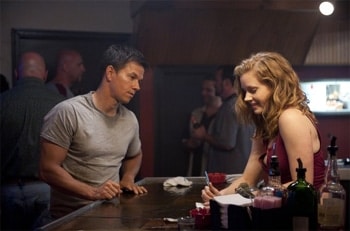
Fun and Games: Three weeks later. Alice has arranged a new match for Micky, but he is nowhere to be found. In a profanity-ridden exchange, Alice’s daughters reveal that Micky is with “that (expletive) girl from the bar. That (expletive) girl Charlene… I hear she likes three ways — with other girls… like those MTV girls.”
Alice tells her daughters to go get Micky. She will find Dicky, and bring him home.
Once again, Dicky tries to escape when his mother arrives. Alice is hurt and angry… but Dicky soothes her with a song.
Charlene and Micky wait at the Ward home, surrounded by Micky’s sisters. Their hatred for Charlene is apparent — they consider her an intruder. Charlene’s not “blood”; she’s an outsider.
Alice and Dicky arrive. Alice lays out the plan for the next match… but Micky and Charlene question the wisdom of the match, Alice’s management, and Dicky’s inability to be reliable. After Charlene suggests that Micky should take up the Vegas offer, the Ward women begin a verbal assault upon her. Micky defends Charlene; the tightly-woven fabric of this family has begun to unravel.
Dicky makes Micky a deal — he’ll get money for Micky’s training, if Micky stays — and trains with him — in Lowell.
Charlene meets Micky’s daughter; the three of them form a casual family unit.
Night. The Ward clan goes out to dinner; Micky brings Charlene. In a darkened alley, Dicky pimps out his girlfriend. She performs oral sex on a business man; Dicky and an accomplice arrive and impersonate police. They pull the man out of the car and rob him… only to have a squad car arrive on the scene. A chase begins through the streets of Lowell.
Midpoint: A man bursts into the restaurant where the Wards are. He tells them that there is a fight outside; police are beating Dicky. The family rushes outside — but George, O’Keefe, and Charlene urge Micky to remain inside. Micky ignores them and rushes to defend his brother… and is beaten by angry cops. His right hand is pummeled with a nightstick. Micky and Dicky are arrested. (beginning of the A & B intersection)
Bad Guys Close In: A courtroom. Micky is released on his own recognizance — but this is Dicky’s 27th arrest.
After the court, Micky and Dicky argue. Micky tells his brother that he is “done with” him. Micky is transferred to prison.
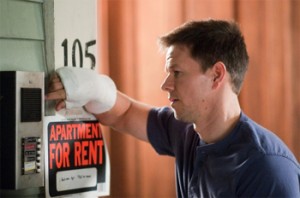
Micky goes to Charlene’s house, but she refuses to answer the door. She is angry that he continues to allow his family to sabotage his career. She tells him that he does not need Dicky to succeed… and sends him on his way. (the intersection of the A & B story is fully realized)
In prison, Dicky experiences the hell of withdrawal.
At home, Micky faces his own withdrawal from the life of a prized fighter. Townspeople shun him. After all, he has abandoned Dicky, the town pride.
The HBO documentary airs. The inmates at the prison are assembled to watch what is expected to be a celebration of Dicky’s life as a boxer. The film begins…
A shot of Dicky and a friend in a car. A title card reads:
CRACK IN AMERICA
As Dicky and his friend talk about their usage.
Micky watches in his apartment; the Ward clan watches from their home. Alice is devastated; she sends Dicky’s son upstairs.
Onscreen, Dicky scores more crack. The inmates laugh.
The video moves to “on the street” segments, interviewing members of Dicky’s extended family. They reveal that they believe that Dicky did not knock Sugar Ray Leonard down; instead, Leonard slipped.
Micky calls Laurie, his daughter’s mother. He asks her to make certain that their daughter is not watching. Laurie tells him that she wants their daughter to see it — so she can see what failures her father and her uncle are.
The video continues. Dicky is forced to face the toll of his addiction — on self, on family, on career. When he sees his son watching him in court, he can bear it no longer. Against the protests of the inmates, he turns the television off:
DICKY
That’s my son. He’s crying, he needs me
and I’m f**king stuck in here?
Alice calls Micky, anguished. Her denial is apparent; she accuses HBO of staging scenes, of setting Dicky up.
As they speak, Charlene knocks on Micky’s door. Micky hangs up on his mother. Wordlessly, Charlene offers Micky comfort.
Dicky wanders the corridors of the prison — alone.
In a series of alternating shots, Micky begins to train in earnest at the gym; Dicky works out in his prison cell. No longer trapped by addiction, he turns his energies into boxing.
The damage to Micky’s hand has healed. Sal Lamato, a fight coordinator, offers Micky a local fight, to give him his confidence back. George, Charlene, and O’Keefe make Micky a proposal: O’Keefe will train Micky — on one condition:
CHARLENE
No crazy time nonsense.
SAL
That’s what its got to be.
O’KEEFE
No Dicky, no Alice.
Mickie agrees. Another tie is broken.
At home, Alice rages at George. She flings dishes at him; she beats him with a pan. The daughters blame Charlene’s influence upon Mickie.
In a display of matriarchal violence, the Ward women swarm en masse to Charlene’s apartment. Micky and Charlene step outside; a fistfight breaks out between the women. Mickie drags Charlene inside and orders his family away.
New Hampshire. Micky’s fight. He travels with his new family — Charlene, Sal, George, and O’Keefe.
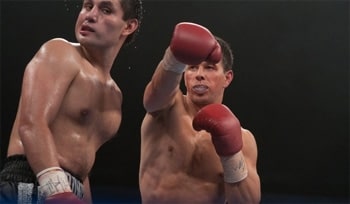
Micky pummels his opponent and scores a solid win.
To the score of Aerosmith’s “Back in the Saddle,” Micky rolls through fight after fight — victorious…
…while Dicky runs lap after lap in prison.
Micky visits Dicky. He has an upcoming fight, to be aired on HBO, with a prizefighter named Sanchez. Dicky tells his brother that he thinks that Sal is using him — as a stepping stone for Sanchez. Dicky is afraid that Micky will go down. He tells him the only way he will win is to take punch after punch, to wear Sanchez down, to take the pain — and then deliver a K.O. blow. Micky refuses his advice; they quarrel.
The fight with Sanchez. Micky follows Dicky’s instruction to the letter — against O’Keefe’s wishes. Dicky is right: Sanchez is a fierce opponent. After six grueling rounds, Micky wears Sanchez down, and delivers a straight kidney punch. Knockout.
During the fight, Dicky tells Alice that Micky is doing precisely what he told him to.
After the fight, Micky learns that Sanchez was a title fighter. Micky is offered a championship fight in London.
All Is Lost: Dicky is released from prison. Alice drives him to the gym, where the daughters have assembled for a homecoming celebration.
Dicky’s ebullient. He knows that he saved Micky from defeat; he is certain that he will be welcomed back into Micky’s fold — but he is not. Micky tells him that he made a promise that he wouldn’t work with Dicky again. Alice is furious; he challenges Micky. He asks him if he could have won the Sanchez fight without his coaching. An argument breaks out. Faced with the truth, Micky confesses to Charlene, George, Sal, and O’Keefe that he couldn’t have won without Dicky.
Charlene and Micky quarrel. Micky accuses Charlene of sounding like his mother. He says he needs them all:
MICKY
I want Dicky back. And I want you, Charlene
and I want O’Keefe. I want my family. What’s
wrong with that?
Charlene and O’Keefe tell Micky that the deal is off, and leave. Another tie broken.
Alice talks Micky into sparring with Dicky — they do, and Micky deliberately takes him down. Alice defends Dicky, but Micky has had enough:
MICKY
(to Alice)
Could this be my fight, Alice? Huh?
Just once? Maybe just this one time,
not for Dicky, huh? I know you think he’s
coming back. He’s forty years old and
doesn’t have a tooth in his head that’s
his f**king own.
The argument escalates. Parents against children, wife against husband, brothers against one another. George and Alice switch allegiances to their sons.
Dark Night of the Soul: The family unit is torn asunder. No whiff of death here; instead, the rank odor of decomposition. The family unit is dead. Micky is left with no one.
Break into Three: Dicky leaves. He carries his celebration cake to the crack house. He gives it to his former friends, and leaves.
Dicky goes to Charlene; they work out a tentative agreement. They will stand together for Micky.
Micky pulls up to discover Dicky and Charlene together. Micky’s family is restored. A & B have joined as one.
Finale: London. The championship fight. Micky and his team arrive (Gathering the Team).
Micky and his opponent are weighed. During a press conference, the opponent, Neary, belittles Micky. Micky’s conviction is unwavering. He deflects the taunts; his confidence is restored.
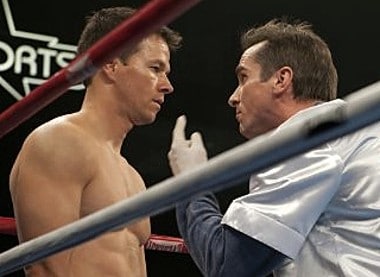
Dicky accompanies his brother to the ring (Storming the Castle); together, they sing to WhiteSnake’s cover of “Here I Go Again On My Own”… and yet, they have each other. Micky steps into the ring (Executing the Plan).
The bell rings. The fight begins. Micky is beaten over and over; he takes punch after punch to the gut. Micky tries to match Neary blow for blow… but Neary is unrelenting. Round after round, Micky struggles to keep up with his opponent. Neary begins to deliver a series of well-placed body shots. Micky goes down (The High-Tower Surprise)…
…and Dicky comes to him in the ring. While O’Keefe ministers to his wounds, Dicky delivers his one-two punch of love:
DICKY
…you gotta win a title. For you. For me.
For all.
Once again, Micky listens to the advice of his brother.
The fight resumes. Once again, Micky is pummeled. Again. And again. Relentless. He seems on the verge of collapse (Dig, Deep Down)…
…when his confidence — and his strength — are restored. Micky drives punch after punch at Neary. He does not waver (Execution of New Plan).
Neary goes down. Micky has won.
Final Image: Micky and Dicky, together on a couch. “Who used to be the pride of Lowell, huh?” Dicky says as he points to himself. “Right here. Who’s the pride of Lowell, now? Right there,” he says as he points to Micky.
Honor has been restored. Transformation through completion.
Next week’s blog: From “The Best of Blake”
BJ Markel
16 Comments
Leave a Reply Cancel reply
You must be logged in to post a comment.


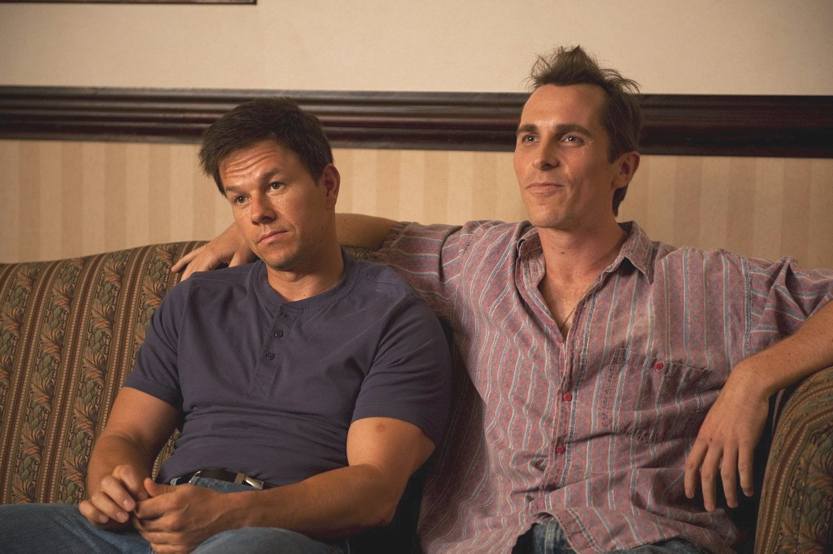
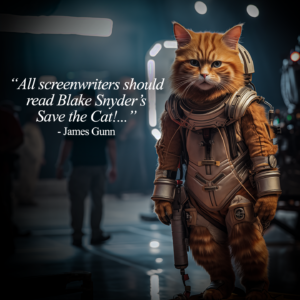






Wow!
Brilliant breakdown, Anne; it took me back to the movie and to emotions I experienced. It doesn’t get better than that!
Anne,
Beautifully examined! So well written. THANK YOU!
Hi Jaime and Bradford ~
Thank you so much!
It was a challenging script – and film – to break down. On the surface, it seems very simple, and yet, this is one of the most “onioned” stories I’ve run across. Genre presented its own challenged; often, the film felt very Institutionalized – the suppression of the matriarchal domination from all sides – and yet, at the end of the day, what we have are two half-men that each become whole through each other.
It’s a magnificent story. Privately, I am working on taking the main CHARACTERS and creating their own BS2’s to track their journeys. An exercise I encourage.
Again, many thanks for the support. I thoroughly enjoyed this workout.
best,
anne
Errr… “challenge,” not “challenged.”
THE FIGHTER K.O.’d me. :)
Great breakdown! Loved this picture. I’m drawn to the ambiguity of the title: Which brother is THE FIGHTER? Your analysis answers the question. “Brother depends upon brother, our heroes are incomplete. The theme of The Fighter is that of family — how family is defined, the familial ties that bind, those that unravel, and the ties that are torn apart. … Transformation through completion.”
Your word choice and descriptions are amazing. I didn’t just see the movie as described…I felt it too! WOW
Way to go Annie!
Al and Melody ~
Coming from you, praise indeed.
The genre had me stymied; there is a great deal of the film that feels Institutionalized… and yet, at the end of the day, it is about two people journeying to completion through one another.
So, I punted and came up with FAMILY LOVE as a Buddy Love variation.
I really enjoyed rolling up my sleeves, and Digging Deep Down with THE FIGHTER. Thank you for your kind words!
anne
Isn’t the debate supposed to be directly out of the catalyst. Protag debating a catalyst situation?
In your BS he lost the fight in the catalyst. The debate is born during the debate, not the catalyst. Not sure th is right.
Ie; Rain Man, catalyst is phone call about Rain Man. Debate, should I take trip with him. The debate was born directly from catalyst.
The Fighter – I will be fighting bigger guy. Debate, should I fight him. The way you have it he’s lost the fight. The new offer comes during your debate and then he debates.
Let’s get some breakdowns for a couple of masterpiece scripts. Affliction, Sling Blade, Taxi Driver, You Can Count on Me, even One Hour Photo. Love STC, but as I often discussed with Blake, it isn’t applied often enough to smart reallynwell written material. Too often it’s applied to simple, bland, pop stuff. I want to see breakdowns for all the best original screenplay nominees over the past 20 years. Now there’s a ne wSTC book!
In fact I had one of the STC pros try to breakdown Affliction and he admirably got the catalyst wrong. These scripts are tough to break but when you do much more usefull than seeing a Blind Side breakdown. Time to take STC to the next level.
Hi Michael ~
Interesting thoughts re: Debate; however, I’m a little confused by your post, as I did beat a Debate was born directly from the Catalyst: ie, I was trounced, my family let me take a dive, should I continue to stay with them, or should I go to Vegas? He decides to stay with them. The new offer comes as a result of the Catalyst – the loss of the fight:
“The package that arrives in Romancing the Stone which will send Joan Wilder (Kathleen Turner) to South America; the telephone call that informs Tom Cruise his father has died in Rain Man; the dinner at which Reese Witherspoon’s fiancé announces he’s dumping her in Legally Blonde – these are the catalyst moments: telegrams, getting fired, catching the wife in bed with another man, news that you have three days to live, the knock at the door, the messenger. In the set-up you, the screenwriter, have told us what the world is like and now in the catalyst moment you knock it all down. Boom!” – Blake Snyder, SAVE THE CAT
As Blake trained us, a simple “Wow, I’m fighting a bigger guy.” is not a Catalyst. The Catalyst must turn the hero’s world (or heroes in this case) upside down. It must be PRIMAL. It must be a PUNCH. By applying STC! principles, the Catalyst is indeed, Micky’s loss in the ring.
In regard to your second post, I’d suggest that you take a look at the archives, as several critically acclaimed films have been broken down, including WINTER’S BONE, (500) DAYS OF SUMMER, INGLORIOUS BASTERDS, MEMENTO, DISTRICT 9, PRECIOUS, THE HURT LOCKER, UP IN THE AIR… and many others.
So, why not take the STC! challenge, and beat out a film that you’d like to see? You can them submit it to STC for consideration for publication on the blog site. Walking the walk is a rewarding – though exhausting – challenge.
Best of luck with the words!
Anne
Annie,
Great work. I love the level of detail, especially in the finale. I deeply appreciate the work that goes into these. I’ve found in the analyses I’ve done that the BGCI sequence often has other beats hidden inside it, especially if it’s a buddy film, or one with multiple protagonists. I noticed here that there was a lot of information that fell under that heading in yours. I would suggest that there are actually a couple BGCI/All is Lost beats happening in quick succession, and even another Fun & Games beat – the intercutting between the brothers training, rebuilding, reclaiming their promise. That’s success of a kind. But I’m partial to Fun & Games. I think the film STAR WARS has a big important Fun & Games sequence after the midpoint. It’s interesting that you mentioned working on a BS2 for both Dicky and Micky. I’m working on the same with STAR WARS, because the film starts with Princess Leia as the apparent protagonist, but then it follows the robots who take center stage for several minutes before Luke appears, rather late in conventional film storytelling. But of course Luke carries the story from that point forward. I’m attaching my BS2 of “Luke’s Story” here. You’ll see what I mean about Fun & Games. I wonder if you agree? Take care. I look forward to more back and forth.
Best,
Tom
STAR WARS (Luke’s Story)
OPENING IMAGE/CHARACTER: Luke is an earnest, helpful kid working on his foster parent’s farm. Though his intro is innocuous, we hear a heroic theme (Luke’s Theme/Star Wars Theme) when we see him. Luke and his Uncle Owen buy R2 and C3PO from the Jawas. The hand of fate is at work.
SET-UP/CONTEXT OF OPPRESSION: Luke lives a dead-end life on a farm where stasis = death.
HERO’S DESIRE AND PROBLEM: Luke wants to go the Academy next semester, but Uncle Owen needs him for one more season. He reluctantly agrees to stay.
THEME IMAGE/MOMENT: Luke, looking wistfully at the double sunset, longing for adventure and dreaming of a bigger, more fulfilling and meaningful life. Luke’s theme soars on the soundtrack to bring this point home.
CATALYST/DISCOVERY-NEW PROBLEM – MISSION #1: Luke discovers R2 has escaped because he (Luke) removed the restraining bolt. The pursuit of R2 leads Luke to Obi-Wan and a discovery of his past and a whole new world of adventure, and a mission: deliver R2 to Princess Leia’s father on Alderaan.
DEBATE: Luke refuses to accompany Obi-Wan to Alderaan because he stands by his commitment to his Aunt and Uncle. The Debate ends when Luke discovers them dead.
BREAK INTO 2: The departure for Mos Eisley and a way off Tatooine to Alderaan (Mission #1), all the while pursued by Stormtroopers.
B STORY: Meeting Han solo and Chewbacca (Princess Leia has already been introduced).
FUN AND GAMES: Obi-Wan’s bar fight; Han’s bar fight; escaping the Imperial Star Cruisers with the jump to Light-Speed/Hyperspace; Obi-Wan mentoring Luke in the ways of “The Force”; Holo-chess.
MIDPOINT: The Heroes discover Alderaan destroyed (Mission #1 ends in failure) and the Millennium Falcon is sucked into the Death Star – into the Belly of the Beast/Inmost Cave.
MORE FUN AND GAMES: Heroes smuggle themselves; in disguise they free the Princess; watching Obi-Wan use The Force; watching Luke be a hero and get a good luck kiss from the Princess as he flies across the bridge, watching Han be stupidly courageous, Obi-Wan’s light saber duel with Darth Vader.
CATALYST/DISCOVERY-NEW PROBLEM A NEW MISSION: Heroes discover Princess is on Death Star, in jail. Luke organizes Mission #2: Rescue her.
BAD GUYS CLOSE IN: Trapped in the garbage disposal
ALL IS LOST: Obi-Wan slain by Darth Vader.
DARK NIGHT OF THE SOUL: Luke is devastated over the loss of Obi-Wan.
BREAK INTO 3: The Rebels determine the Death Star’s weakness and prepare for ship-to-ship combat.
FINALE: Luke, with the spiritual guidance of Obi-Wan, the encouragement of Leia, the help of R2 and the last second assist from Han and Chewie, evades Darth Vader and destroys the Death Star.
FINAL IMAGE: Luke, a hero, gets a medal from the Princess and an ovation from the Rebel Alliance.
Hi Tom ~
This is wonderful.
I was a stage actress before I began playwriting (and now have made the transition to screenwriting). Beating out a character was second nature to me then, and, as I was working on THE FIGHTER, began to appreciate what a useful tool the BS2 is for a character arc.
In regard to THE FIGHTER – yes, I believe there are “minis” and switches between the beats. For example, in my notes when I wrote “Dicky wanders the corridor – alone,” I followed with “Dicky’s All Is Lost.”
For clarity’s sake, I decided to follow the straight line… but yes, Buddy Films such as this (and boy, doesn’t Alice have her own BS2?!) are very layered and complex… and the beats may switch back and forth in a seeming non-linear fashion.
Love your work on STAR WARS. Just goes to prove that there is no such thing as a “simple” story. :)
best,
anne
Amen to that (your last line). I’m beating out Paul Haggis’ CRASH right now, story by story. Talk about complex, especially considering the artful overlaps. It was accused of being articial, but I find that criticism ridiculous. It’s a triumph of craft. Fourteen complete stories. I think the organizaing principle for the whole story was “irony.” Here’s just a taste.
CRASH
Character / Story Design
1. Graham (vs. Rick [through Flanagan)
Sympathetic protagonist – negative outcome.
A good, honest cop with integrity forced to betray his values for sake of his brother’s welfare. But his brother is already dead, and his mom blames him for it.
Tragic: The hammer of God falls hard on the virtuous, especially if the virtuous happens to be a black man in a white man’s world. Bitterly ironic.
2. Farhad (vs. Daniel)
Unsympathetic protagonist – positive outcome.
A religious, play-by-the-rules Iranian shopkeeper forced to commit revenge killing on innocent man, but ends up feeling reborn when guan fails to go off.
Uplifting: A seemingly unworthy soul is saved by luck, or is it, as he believes, Allah’s intervention? – deeply ironic.
3. Officer Ryan (vs. Christine, vs. Shaniqua, vs. Christine again)
Unsympathetic protagonist – positive outcome.
A hateful man (racist white cop) redeems himself through heroic action
Uplifting: God’s Grace in action (?) – deeply ironic.
4. Officer Hansen (vs. Ryan, vs. Cameron, vs. Peter)
Sympathetic protagonist – negative outcome.
After heroic action, a virtuous man (white cop) undone by fatal misunderstanding.
Tragic: The Hammer of God falling hard again – deeply ironic.
5. Daniel (vs. Jean, vs. Farhad)
Sympathetic protagonist – positive outcome.
A virtuous man (Hispanic locksmith) spared by fate.
Uplifting: God’s Grace in action (?) – deeply ironic.
6. Cameron (vs. Officer Ryan, vs. Christine, vs. Anthony & Peter, vs. Hansen)
Sympathetic protagonist – positive outcome.
A virtuous man (black TV director) driven to rage-filled confrontation, saved by man inspired to right a wrong, lives to forgive and reconcile with estranged wife.
Uplifting: God’s Grace in action (?) – deeply ironic.
7. Christine (vs. Officer Ryan, vs. Cameron, vs. Officer Ryan again)
Unsympathetic protagonist – positive outcome.
A pushy, spoiled woman (rich white housewife) saved by man who humiliated her, lives to reconcile with estranged husband she had pushed away.
Uplifting: God’s Grace in action (?) – deeply ironic.
8. Anthony (vs. Rick & Jean, vs. Choi, vs. Lucien, vs. Cameron)
Unsympathetic protagonist – positive outcome.
A criminal (selfish black youth) spared by fate and redeemed through heroic action
Uplifting: Go.d’s Grace in action (?) – deeply ironic.
9. Peter (vs. Rick, vs. Choi, vs. Cameron, vs. Officer Hansen)
Sympathetic protagonist – Negative outcome.
A criminal (benevolent black youth) after heroic action, undone by fatal misunderstanding.
Tragic: Hammer of God falls hard – deeply ironic.
10. Rick (vs. Anthony & though he becomes increasingly less sympathetic) – positive outcome.
A powerful man (white D.A.) manipulates system for his own ends.
Depressing: God turns a blind eye to the machinations of the powerful
No irony here – just the way it is in white America.
11. Jean (vs. Anthony & Peter, Maria)
Unsympathetic protagonist – positive outcome.
A neurotic woman (rich white housewife) redeems herself through benign self-discovery.
Quietly uplifting: God’s Gentle Grace in action (?) – ironic.
12. Shaniqua (vs. Officer Ryan, vs. Hispanic Drivers)
Sympathetic protagonist – positive and negative outcomes; two story threads:
1. Delivering Officer Ryan’s comeuppance (positive for her, negative for him); and
2. Gets rear-ended and reveals true colors – she’s as temperamental and racists as he is!
Depressing/humorous – deeply ironic.
13. Kim Lee (vs. Ria, vs. Nurse)
Unsympathetic protagonist – positive outcome.
An obnoxious woman (pushy Korean) reunited with injured husband and ill-gotten gains.
Outrageous/depressing/humorous – deeply ironic.
14. Choi (vs. Anthony in van)
Sympathetic protagonist (appears sympathetic, hit by a damn car!) – positive outcome.
A seemingly upright and sympathetic man (Korean businessman and hit-and-run victim) reunited with wife and ill-gotten gains (money for trafficking in human slavery!).
Outrageous/depressing/humorous – deeply ironic.
WHEW!
Really enjoyed the breakdown, Annie.
I’m not sure if Micky losing the fight to the heavier opponent is the Catalyst. If this was the story about him going to Vegas to train, then it would be. Or if he stopped boxing then it would be. But to me it feels like the “A” story is: a boxer who is overlooked and held back by his family falls in love with a girl who helps him realize his potential. The Break Into Two is Micky and Charlene beginning their relationship. How is that related to Micky losing the fight? It seems to me that the Catalyst is Micky meeting Charlene (which, incidentally, happens at minute 12). Mickey getting bad advice from his Mother and Dicky to fight the heavier boxer seems to be just set-up, or the status quo, and what is different and sets this story in motion is Micky meeting Charlene. Maybe my understanding of the Catalyst isn’t correct, because I would also argue that Tom Cruise getting the phone call in Rain Man isn’t the catalyst. It doesn’t affect him at all. What sets the story in motion is that his inheritance is given to someone else. If that didn’t happen he would have returned to his normal life and there would be no transformation and no story.
Thanks, Annie. Makes sense.
I agree with Sam, Meeting Charlene is the catalyst and the debate, and then she presents the question for him to leave his “family” to be the there team- she represents the B part of the story I believe.